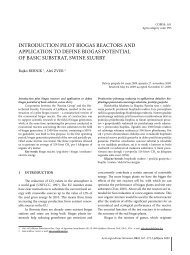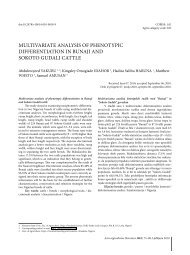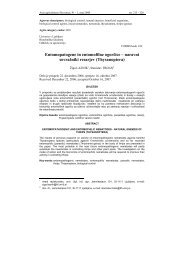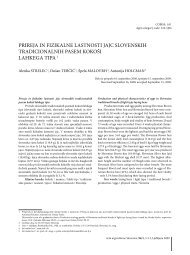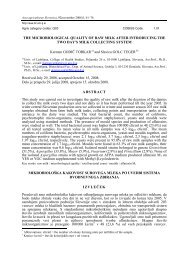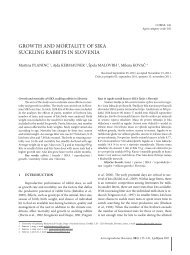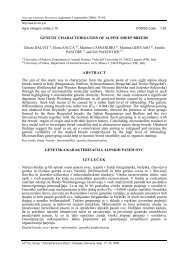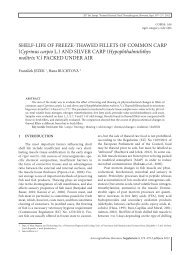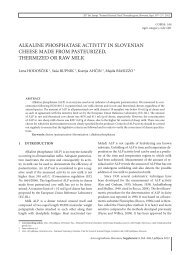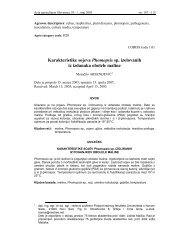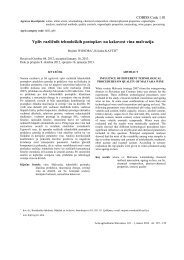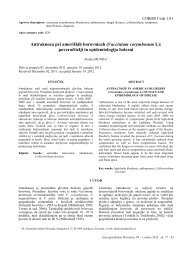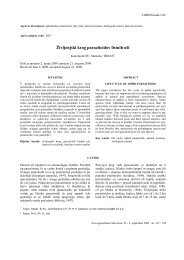geography of cika cattle breed 1 - Acta agriculturae Slovenica ...
geography of cika cattle breed 1 - Acta agriculturae Slovenica ...
geography of cika cattle breed 1 - Acta agriculturae Slovenica ...
Create successful ePaper yourself
Turn your PDF publications into a flip-book with our unique Google optimized e-Paper software.
GEOGRAPHY OF CIKA CATTLE BREED 1<br />
Metka ŽAN LOTRIČ 2 , Andrej ŠALEHAR 3 , Drago KOMPAN 3<br />
Geography <strong>of</strong> Cika <strong>cattle</strong> <strong>breed</strong><br />
The <strong>geography</strong> <strong>of</strong> Slovenian autochthonous Cika <strong>cattle</strong><br />
<strong>breed</strong> was studied over a 140-year period <strong>of</strong> its development.<br />
The first literature reference regarding the dissemination range<br />
<strong>of</strong> original Cika <strong>cattle</strong> was found in the year 1872, when Schollmayr<br />
(1873) studied <strong>cattle</strong> <strong>breed</strong>s in Carniola. In the second<br />
half <strong>of</strong> the 19 century, <strong>cattle</strong> in Carniola were without their own<br />
names <strong>of</strong> <strong>breed</strong>s and were characterized by a large phenotypic<br />
diversity. A generic term “Carniolan <strong>cattle</strong>” was the most commonly<br />
used name and animals were grouped according to their<br />
colour. Povše (1893) reported that the red coloured Gorenjska<br />
<strong>cattle</strong> were to the fullest extent spread in the area which today<br />
belongs to Gorenjska statistical region. Under the influence <strong>of</strong><br />
specific climate and <strong>breed</strong>ing conditions in Bohinj area, the<br />
smallest in size and the most dairy type <strong>of</strong> Cika <strong>cattle</strong> was developed<br />
here. They named it as “Bohinj <strong>cattle</strong>” and this was the<br />
original form <strong>of</strong> Cika <strong>cattle</strong>. Breeding <strong>of</strong> Cika <strong>cattle</strong> maintained<br />
in the same area until the sixties <strong>of</strong> the past century. In the year<br />
1964 a symposium took place in Kranj, where it was decided<br />
that Cika <strong>cattle</strong> was going to get upgraded by Simmental <strong>breed</strong>.<br />
Today, the <strong>breed</strong>ing <strong>of</strong> Cika <strong>cattle</strong> is dispersed across a larger<br />
area <strong>of</strong> the Republic <strong>of</strong> Slovenia, however, it is the most widespread<br />
in the north part <strong>of</strong> Central Slovenian statistical region<br />
(Kamnik area) and Gorenjska, especially in the south-eastern<br />
part <strong>of</strong> Julian Alps (Bohinj area). In these two areas, Cika <strong>cattle</strong><br />
<strong>breed</strong>ing is still most concentrated.<br />
Key words: <strong>cattle</strong> / autochthonous <strong>breed</strong>s /Cika <strong>cattle</strong>/<strong>geography</strong><br />
/origin area/Slovenia<br />
COBISS: 1.01<br />
Agris category code: L01<br />
Received November 19, 2012; accepted November 26, 2012.<br />
Delo je prispelo 19. novembra 2012, sprejeto 26. novembra 2012.<br />
Geografija pasme <strong>cika</strong>stega goveda<br />
Geografijo slovenske avtohtone pasme <strong>cika</strong>sto govedo<br />
smo proučevali v 140 letnem obdobju njenega razvoja. Prvo<br />
najdeno gradivo s tega področja izvira iz leta 1872, ko je Schollmayr<br />
(1873) raziskoval »goveja plemena« na Kranjskem. V drugi<br />
polovici 19. stoletja govedo na Kranjskem večinoma ni imelo<br />
imen za pasme in zanj je bila značilna velika fenotipska heterogenost.<br />
Za poimenovanje so največkrat uporabljali splošen<br />
izraz »kranjsko govedo«, živali pa so združevali v skupine po<br />
barvi. Povše (1893) piše, da je bilo rdeče pisano gorenjsko govedo<br />
v največjem obsegu razširjeno na območju, ki danes spada<br />
v Gorenjsko statistično regijo. V Bohinju se je pod vplivom<br />
specifičnih klimatskih in rejskih razmer oblikoval najmanjši in<br />
relativno najbolj mlečni tip <strong>cika</strong>stega goveda, ki so ga imenovali<br />
bohinjsko govedo in je izvorna oblika <strong>cika</strong>stega goveda. Reja<br />
<strong>cika</strong>stega goveda se je na območju, kjer so vsaj od druge polovice<br />
19. stoletja naprej redili rdeče govedo, v podobnem geografskem<br />
obsegu ohranjala do 60. let 20. stoletja. Leta 1964 je<br />
v Kranju potekal simpozij, kjer so sprejeli sklep o pretopitvi <strong>cika</strong>ste<br />
pasme z lisasto. Danes je reja <strong>cika</strong>stega goveda geografsko<br />
razpršena po večjem območju republike Slovenije, številčno pa<br />
je najmočneje zastopana v severnem delu Osrednjeslovenske<br />
statistične regije (območje Kamnika) in v Gorenjski statistični<br />
regiji, zlasti v jugovzhodnem delu Julijskih Alp (območje Bohinja).<br />
Na teh dveh območjih je reja <strong>cika</strong>stega goveda najbolj<br />
zgoščena.<br />
Ključne besede: govedo / avtohtone pasme / <strong>cika</strong>sto govedo<br />
/ geografija /izvorno območje/ Slovenija<br />
1 The article is part <strong>of</strong> the doctoral dissertation »Development <strong>of</strong> Cika Cattle Breed and Alpine Dairy Farming«, issued by Metka Žan Lotrič, Ph.D., supervisor pr<strong>of</strong>.<br />
Drago Kompan, Ph.D. / Prispevek je del doktorske disertacije dr. Metke Žan Lotrič »Razvoj pasme <strong>cika</strong>stega goveda in planšarstva«, mentor pr<strong>of</strong>. dr. Drago Kompan<br />
2 Univ. <strong>of</strong> Ljubljana, Biotechnical Fac., Dept. <strong>of</strong> Animal Science, Groblje 3, SI-1230 Domžale, Slovenia, metka.zan@bf.uni-lj.si<br />
3 Same address as 2<br />
<strong>Acta</strong> argiculturae <strong>Slovenica</strong>, 100/2, 139–148, Ljubljana 2012
140<br />
M. ŽAN LOTRIČ et al.<br />
1 INTRODUCTION<br />
In the 19th century, the <strong>cattle</strong> in Carniola were characterized<br />
by a large phenotypic diversity. On the one hand<br />
this was due to the fact that the small ruminants <strong>breed</strong>ing<br />
(especially sheep <strong>breed</strong>ing) was the main branch <strong>of</strong> animal<br />
husbandry (Stefančič, 1966), while there was a lack<br />
<strong>of</strong> selection work in <strong>cattle</strong> <strong>breed</strong>ing, which would prevent<br />
the phenotypic diversity. The second reason was the import<br />
<strong>of</strong> foreign <strong>breed</strong>ing animals by the lords <strong>of</strong> the land<br />
which did not take into account any basic pr<strong>of</strong>essional<br />
and zootechnical measurements at all. According to the<br />
<strong>cattle</strong> diversity, animals were different from each other in<br />
body weight, skin or hair colour, etc. Therefore, there was<br />
no systematic description regarding the <strong>breed</strong>ing standard.<br />
Domestic <strong>cattle</strong> were most <strong>of</strong>ten <strong>of</strong> white, grey or red<br />
skin colour (Bleiweis, 1871). Schollmayr (1873) studied<br />
<strong>cattle</strong> <strong>breed</strong>s in Carniola and wrote that animals significantly<br />
differed from each other in phenotyp, and were<br />
named according to the colour.<br />
After the March revolution, opportunities to promote<br />
domestic <strong>cattle</strong> <strong>breed</strong>ing increased and in the year<br />
1868 Carniola Agricultural Society started with planned<br />
<strong>Acta</strong> <strong>agriculturae</strong> <strong>Slovenica</strong>, 100/2 – 2012<br />
purchasing <strong>of</strong> <strong>breed</strong>ing animals <strong>of</strong> foreign <strong>breed</strong>s especially<br />
bulls <strong>of</strong> Bela, Pinzgauer, Marijadvor and Muricidol<br />
<strong>breed</strong> (Reja goveje živine …, 1877).<br />
An important basis for the conservation and sustainable<br />
use <strong>of</strong> animal genetic resources is to study the<br />
<strong>geography</strong> <strong>of</strong> livestock, which examines the prevalence<br />
<strong>of</strong> certain types <strong>of</strong> farming and primary distribution <strong>of</strong><br />
<strong>breed</strong>s <strong>of</strong> farm animals. This is particularly important for<br />
the in situ conservation which means the conservation <strong>of</strong><br />
in vivo agricultural genetic resources in the environment<br />
where they were created and where they developed their<br />
distinctive properties (Šalehar et al., 2005).<br />
In the area <strong>of</strong> Carniola where red colour <strong>cattle</strong><br />
was widespread in the second half <strong>of</strong> the 19th century<br />
the only Slovenian autochthonous <strong>breed</strong> <strong>of</strong> <strong>cattle</strong> was<br />
evolved and conserved over several decades. In Bohinj,<br />
the original type <strong>of</strong> Cika <strong>cattle</strong> was kept for the longest<br />
time. The <strong>breed</strong>ing aim <strong>of</strong> Cika <strong>cattle</strong> is associated with<br />
the social and market changes, which is shown in the<br />
present internal structure <strong>of</strong> the total population (distribution<br />
<strong>of</strong> animals into three types: Cika type, partly<br />
Cika type and Pinzgauer type). Only the animals <strong>of</strong> Cika<br />
type are presented as original Cika <strong>breed</strong> and they are an<br />
Figure 1: Geography <strong>of</strong> differently coloured <strong>cattle</strong> by district in Carniola in 1872 (Schollmayr, 1873)<br />
Slika 1: Geografija različno obarvanega goveda po posameznih okrajih Kranjske v letu 1872 (Schollmayr, 1873)
excellent base for the primary <strong>breed</strong>ing aim (Žan Lotrič,<br />
2012). In our study the geographic distribution <strong>of</strong> Cika<br />
<strong>cattle</strong> <strong>breed</strong>ing has been investigated from 1872 onwards.<br />
2 MATERIAL AND METHODS<br />
In researching Cika <strong>cattle</strong> <strong>breed</strong>, numerous historical<br />
sources were found and studied. They all showed the<br />
development <strong>of</strong> this <strong>breed</strong> in the Republic <strong>of</strong> Slovenia.<br />
The main sources were found in the Contributions to<br />
Bibliography: Historical Sources <strong>of</strong> Slovenian Autochthon<br />
and Traditional Breeds <strong>of</strong> Domestic Animals – to<br />
the year 1945 (Šalehar, 2009), Contributions to Bibliography:<br />
Legislation on the Area <strong>of</strong> Cattle Breeding for<br />
Slovenia in the years 1740–1945 (Šalehar, 2011a) and<br />
Contributions to Bibliography: Slovenian Books and<br />
Prints on Cattle Breeding Area (Šalehar, 2011b), which<br />
includes the period to the year 1945. All mentioned references<br />
as well as some periodical publications and books<br />
in the field <strong>of</strong> animal husbandry used in this study are<br />
available on the website <strong>of</strong> Digital Library <strong>of</strong> Slovenia,<br />
DLIB.si. A review <strong>of</strong> these works gave us a starting base<br />
<strong>of</strong> bibliographic information, which guided our work in<br />
reviewing materials and sources that are stored in different<br />
libraries in Slovenia. Some references were also found<br />
in the Archives <strong>of</strong> the Republic <strong>of</strong> Slovenia.<br />
The historical sources were also searched by means<br />
<strong>of</strong> COBIB.SI, the joint bibliographic-catalogue database<br />
<strong>of</strong> the National and University Library in Ljubljana,<br />
Catalogue 1774–1947, electronic catalogue Katnuk, and<br />
database <strong>of</strong> the National Museum <strong>of</strong> Slovenia, different<br />
catalogues and other library databases. A lot <strong>of</strong> books on<br />
<strong>cattle</strong> <strong>breed</strong>ing and Alpine dairy farming were found in<br />
the library <strong>of</strong> the Zootechnical Department at Biotechnical<br />
Faculty, University <strong>of</strong> Ljubljana, in other Slovenian<br />
libraries, in the University Library in Graz and in the Library<br />
in Gorizia. Some materials were found on the web<br />
site ALEX – Historische Rechts und Gesetzestexte Online<br />
(Alex, 2011) and on the web site Sistory – History <strong>of</strong><br />
Slovenia (Sistory, 2011). A web site browser Google-book<br />
and some others were also <strong>of</strong> great help.<br />
Data for the presentation <strong>of</strong> Cika (Bohinj) <strong>cattle</strong><br />
<strong>geography</strong> are mainly found in the material as follows:<br />
Schollmayr (1873), Povše (1893), Wenko (1933), Selan<br />
(1939), Ferčej (1947), Ferčej & Skušek (1990) and Jeretina<br />
(2011). The <strong>geography</strong> <strong>of</strong> Cika (Bohinj) <strong>cattle</strong> was<br />
studied in the time period 1872–2011.<br />
First <strong>of</strong> all, the found data had to be unified and<br />
organized, and the old pr<strong>of</strong>essional terms had to be replaced<br />
by the current ones.<br />
3 RESULTS<br />
GEOGRAPHY OF CIKA CATTLE BREED<br />
3.1 FIRST DESCRIPTIONS OF CIKA CATTLE GE-<br />
OGRAPHY<br />
Kump and Ločniškar (1956) described the first<br />
found record <strong>of</strong> Cika <strong>cattle</strong> <strong>breed</strong>ing <strong>geography</strong>, and presented<br />
it according to the report published in the year<br />
1768. There it is noted that the west part <strong>of</strong> Kamnik and<br />
Ljubljana is the area <strong>of</strong> monochrome yellow-red small<br />
<strong>cattle</strong>. Furthermore, parallel with the improvement <strong>of</strong><br />
transportation facilities the influence from other countries<br />
increased, associated with the introduction <strong>of</strong> foreign<br />
<strong>breed</strong>s <strong>of</strong> <strong>cattle</strong>. Only the most remote places <strong>of</strong> our<br />
country were not reached by the influence from abroad<br />
and thus the original <strong>cattle</strong> was conserved there for the<br />
longest time. Bohinj area was until the opening <strong>of</strong> the<br />
railway in 1906 the most isolated region <strong>of</strong> Julian Alps,<br />
therefore the original type <strong>of</strong> Cika <strong>cattle</strong> was kept there<br />
for the longest time (Žan Lotrič, 2012).<br />
3.2 GEOGRAPHY OF CIKA CATTLE IN CAR-<br />
NIOLA IN THE SECOND HALF OF THE 19 TH<br />
CENTURY<br />
3.2.3 GEOGRAPHY OF CARNIOLA CATTLE IN<br />
THE YEAR 1872<br />
Schollmayr (1873) studied <strong>cattle</strong> <strong>breed</strong>s in Carniola<br />
and he found a large phenotypic heterogeneity between<br />
animals, they were even without their own <strong>breed</strong> names.<br />
Carniola <strong>cattle</strong> was named according to the colour and<br />
the author has counted 21 common descriptive names<br />
(for example ”mavra” was the name <strong>of</strong> <strong>cattle</strong> with full<br />
black or at least very dark colour, yellowish <strong>cattle</strong> was<br />
in Dolenjska called »volk« and in Notranjska »rmenka«,<br />
»plavka«). Therefore Schollmayr (1873) distributed them<br />
by colour. Geographical distribution <strong>of</strong> different colours<br />
<strong>of</strong> <strong>cattle</strong> in Carniola in the year 1872 is presented in Fig.<br />
1.<br />
In the second half <strong>of</strong> the 19th century there were six<br />
<strong>breed</strong>ing areas <strong>of</strong> differently coloured <strong>cattle</strong> in Carniola<br />
(Fig. 1). In the area <strong>of</strong> former municipalities <strong>of</strong> Kranjska<br />
Gora, Radovljica and Tržič red <strong>cattle</strong> was bred already in<br />
the seventies <strong>of</strong> the 19 century. In the same period red<br />
<strong>cattle</strong> was also bred in the former municipalities <strong>of</strong> Brdo<br />
by Lukovica, Kamnik, Kranj, Šk<strong>of</strong>ja Loka, Idrija and in<br />
the small area <strong>of</strong> Vrhnika municipality. Pirc (1884) stated<br />
two main <strong>cattle</strong> types in Carniola. He called them:<br />
– – »white, white-yellow or grey <strong>breed</strong>«,<br />
– – »red, red-Cika <strong>breed</strong>«.<br />
<strong>Acta</strong> <strong>agriculturae</strong> <strong>Slovenica</strong>, 100/2 – 2012 141
142<br />
M. ŽAN LOTRIČ et al.<br />
Figure 2: Geography <strong>of</strong> <strong>cattle</strong> <strong>breed</strong>s in Carniola in 1893 (Povše, 1893)<br />
Slika 2: Geografija pasem goveda na Kranjskem leta 1893 (Povše, 1893)<br />
3.2.2 GEOGRAPHY OF CARNIOLA CATTLE IN<br />
THE YEAR 1893<br />
A similar study was published two decades later by<br />
Povše (1893) (Fig. 2). The <strong>cattle</strong> was still mainly named<br />
according to colour. The red coloured <strong>cattle</strong> which was<br />
widespread in Gorenjska was named “Red variable coloured<br />
Gorenjska <strong>cattle</strong>” (predominant red colour had<br />
sometimes white patches). It was the only <strong>breed</strong> kept in<br />
the areas <strong>of</strong> the former districts <strong>of</strong> Kranjska Gora, Radovljica<br />
(except in Bohinj), Tržič, Kranj, Šk<strong>of</strong>ja Loka<br />
and Kamnik. In Bohinj area, farmers bred red coloured<br />
Gorenjska <strong>cattle</strong> and yellow-grey Carniola provincial<br />
<strong>breed</strong>. The latter had been extended to Notranjska and<br />
to a lesser extent also to Dolenjska region. So called “Red<br />
variable coloured Gorenjska <strong>cattle</strong>” was bred, besides<br />
slightly coloured local forms <strong>of</strong> <strong>cattle</strong>, also in the area <strong>of</strong><br />
the former Idrija municipality.<br />
<strong>Acta</strong> <strong>agriculturae</strong> <strong>Slovenica</strong>, 100/2 – 2012<br />
3.2.3 DISTRIBUTION OF CARNIOLA CATTLE<br />
INTO LIVESTOCK DISTRICTS ACCORDING<br />
TO BREEDS<br />
At the meeting <strong>of</strong> the Carniolan Provincial Assembly<br />
on 28 th April 1900, <strong>breed</strong> distribution <strong>of</strong> Carniola<br />
<strong>cattle</strong> in separate regions was highlighted (Govedoreja,<br />
1900). One <strong>of</strong> the members suggested that in the whole<br />
country only one <strong>breed</strong> <strong>of</strong> <strong>cattle</strong> should be kept, namely<br />
Cika (Govedoreja, 1900b). Although present members<br />
believed that Cika could improve <strong>cattle</strong> <strong>breed</strong>ing<br />
throughout the country, they felt that it was not a good<br />
time to vote for only one <strong>breed</strong> <strong>of</strong> <strong>cattle</strong> in Carniola.<br />
In May <strong>of</strong> 1910 the provincial livestock inaugural<br />
gathering was held in Ljubljana where the provincial<br />
dairy and livestock division supervisor Legvart presented<br />
distribution <strong>of</strong> the whole Carniolan territory into three<br />
livestock districts (Gorenjska, Notranjska and Dolenjska),<br />
including their boundaries (Ustanovno ..., 1910).<br />
Within each district only certain <strong>breed</strong>s <strong>of</strong> <strong>cattle</strong> were<br />
allowed. In Gorenjska district, for instance, only the<br />
Pinzgauer sires could be used.
3.2.4 GEOGRAPHY OF CATTLE BREEDS IN<br />
DRAVA BANOVINA<br />
3.2.4.1 BREED DISTRICT OF GORENJSKA<br />
Breed district was an organization that combined<br />
the representatives <strong>of</strong> District livestock committees and<br />
representatives <strong>of</strong> Livestock cooperatives in Gorenjska<br />
(Burgar and Zupan, 1926). This organization was invoked<br />
by the realization that a good and rapid progress<br />
can only be achieved through the association. Ovsenik<br />
(1926a) wrote: »The idea <strong>of</strong> livestock committees and<br />
livestock districts is to create a purebred line <strong>of</strong> Gorenjska<br />
<strong>breed</strong>, to gain the best possible milk yield. The same idea is<br />
present also in the livestock cooperatives ….«.<br />
On the meeting <strong>of</strong> Livestock cooperatives <strong>of</strong> Gorenjska<br />
<strong>breed</strong> district in 1924 held in Kranj, among other<br />
things, it was decided: “All debates related to the <strong>breed</strong><br />
for Gorenjska <strong>breed</strong> district are stopped. The only <strong>breed</strong> for<br />
this district is Pinzgauer <strong>breed</strong> (Gorenjsko …, 1924). The<br />
main aim <strong>of</strong> Gorenjska <strong>breed</strong> district was written by its<br />
secretary Ovsenik (1926b): “The aim <strong>of</strong> our <strong>breed</strong> district<br />
is to equalize our Cika <strong>cattle</strong>, to gain the highest possible efficiency<br />
level and due to proper <strong>breed</strong>ing facilities, selection<br />
work and exchange to get strong and well settled traits …«.<br />
In Selce above the town <strong>of</strong> Šk<strong>of</strong>ja Loka, the first<br />
livestock organization which was named “Livestock Organization<br />
for Red Cika Cattle” was established in 1906<br />
(Ovsenik, 1926c). The idea for a single <strong>breed</strong>ing plan<br />
for the entire <strong>breed</strong> territory began to emerge, as well as<br />
the need to combine livestock organizations into the regional<br />
<strong>breed</strong> groups. On February 13, 1924, Gorenjska<br />
Livestock cooperatives established the Gorenjska <strong>breed</strong><br />
district, which in 1926 consisted <strong>of</strong> 10 Livestock cooperatives<br />
and six District livestock committees. Ovsenik<br />
(1926a) stressed that only the united and good team work<br />
could achieve the target: »To create a pure bred dairy line<br />
<strong>of</strong> Gorenjska <strong>cattle</strong> that will improve the entire <strong>breed</strong>«.<br />
On February 8 th 1926 Gorenjska <strong>breed</strong> district had a<br />
special meeting in Kranj where the rules for <strong>breed</strong> district<br />
and an urgent need for the establishment <strong>of</strong> Livestock cooperatives<br />
where discussed. They accepted a decision for<br />
the immediate establishment <strong>of</strong> Livestock cooperatives,<br />
especially in bigger municipalities. Great emphasis was<br />
given to the proposal <strong>of</strong> dairy school establishment. They<br />
were <strong>of</strong> the opinion that the opening <strong>of</strong> a dairy school in<br />
Slovenia, especially due to pr<strong>of</strong>itable livestock and economy<br />
was <strong>of</strong> vital importance. Therefore the decision was<br />
taken to send the Resolution to the Minister <strong>of</strong> Agriculture<br />
and to the political clubs in the country (Burgar and<br />
Zupan, 1926).<br />
Ovsenik (1930) mentioned the acceptance <strong>of</strong> the<br />
»Recommendations« on the meeting in Kranj on May 8 th<br />
GEOGRAPHY OF CIKA CATTLE BREED<br />
1926 and summarized that the Gorenjska <strong>breed</strong> district is<br />
the central one for all the existing livestock organisations<br />
in the area where Gorenjska Cika <strong>cattle</strong> was bred. The<br />
author stressed that Gorenjska <strong>breed</strong> district is somehow<br />
the central livestock co-operative which needs to be<br />
slowly further developed and to become the <strong>breed</strong> cooperative<br />
association <strong>of</strong> Livestock cooperatives for Gorenjska<br />
Cika <strong>breed</strong>.<br />
3.2.4.2 REGIONS OF SEPARATE CATTLE BREEDS<br />
In December 1938, a conference <strong>of</strong> livestock experts<br />
from different regional managements and delegates <strong>of</strong><br />
livestock cooperative unions was held in Belgrade (Rajoni<br />
…, 1938). They discussed issues related to the improvement<br />
<strong>of</strong> <strong>cattle</strong> <strong>breed</strong>ing, while the Ministry <strong>of</strong> Agriculture<br />
on the base <strong>of</strong> the Act on the improvement <strong>of</strong><br />
livestock, determined the districts for the individual <strong>cattle</strong><br />
<strong>breed</strong>s in the country. In Drava Banovina there was,<br />
among others, a fixed region for the Pinzgauer and local<br />
<strong>breed</strong> (gradually improved by Pinzgauer <strong>breed</strong>) in the following<br />
districts: Radovljica, Kranj, Šk<strong>of</strong>ja Loka, Kamnik,<br />
municipality <strong>of</strong> Žiri in the district <strong>of</strong> Ljubljana region. In<br />
addition to the Drava Banovina, the region <strong>of</strong> Pinzgauer<br />
<strong>cattle</strong> <strong>breed</strong> was specified also for the Sava, Vrbaska and<br />
Primorska Banovina. However, these were regions where<br />
farmers bred heavier <strong>breed</strong> types.<br />
3.2.4.3 BREED DISTRICTS IN DRAVA BANOVINA<br />
In Drava Banovina there were six <strong>breed</strong> districts,<br />
<strong>of</strong> which there were two for Cika <strong>cattle</strong>: Gorenjska and<br />
Ormož (Fig. 3). According to the decree <strong>of</strong> the Ministry<br />
<strong>of</strong> Agriculture Br. 662/III, dated January 3 rd , 1938 (cit.<br />
by Oblak 1938a), the <strong>breed</strong>ing <strong>of</strong> Pinzgauer (Cika) <strong>cattle</strong><br />
was defined in “srez” or political districts: Radovljica,<br />
Kranj, Šk<strong>of</strong>ja Loka, Kamnik, Gorenjska part <strong>of</strong> Ljubljana<br />
district, municipality <strong>of</strong> Žiri, Logatec and Ptuj. Areas <strong>of</strong><br />
<strong>cattle</strong> <strong>breed</strong>s in the Drava Banovina were presented by<br />
Selan (1939) similarly as was done by Wenko (1933).<br />
Hinterlechner (1937) wrote that the main <strong>cattle</strong><br />
<strong>breed</strong>s in Slovenia were the following: Marijadvor,<br />
Pomurje (Muricidol), Murboden, Pinzgauer, Bela, Simmental,<br />
Montafon as well as the provincial or land <strong>cattle</strong>.<br />
The latter was a “mixture” <strong>of</strong> mountain and lowland<br />
<strong>cattle</strong>. Author added that excellent dairy cows could be<br />
found among the land <strong>cattle</strong> and for this reason it would<br />
be necessary to conserve such animals and with selection<br />
consolidate characteristics <strong>of</strong> the animals in their genetic<br />
and good capabilities, especially when a unified type <strong>of</strong><br />
provincial <strong>cattle</strong> is found prevalent in a particular place.<br />
<strong>Acta</strong> <strong>agriculturae</strong> <strong>Slovenica</strong>, 100/2 – 2012 143
144<br />
M. ŽAN LOTRIČ et al.<br />
<strong>Acta</strong> <strong>agriculturae</strong> <strong>Slovenica</strong>, 100/2 – 2012<br />
Figure 3: Areas <strong>of</strong> <strong>cattle</strong> <strong>breed</strong>s in the Drava Banovina (Wenko, 1933)<br />
Slika 3: Pasemska področja goveda v Dravski Banovini (Wenko, 1933)
Figure 4: Geography <strong>of</strong> Gorenjska Pinzgauer <strong>cattle</strong> <strong>breed</strong>ing (Ferčej, 1947)<br />
Slika 4: Razširjenost reje gorenjske pincgavske pasme goveda leta 1947 (Ferčej, 1947)<br />
The author stresses that the provincial <strong>cattle</strong> are usually<br />
very resistant, with good feed conversion, and are generally<br />
very modest.<br />
For each <strong>breed</strong> district in Drava Banovina there<br />
was one Breed association which was at the same time a<br />
subsidiary body <strong>of</strong> Banovina royal administration (Oblak,<br />
1938b). For Gorenjska <strong>breed</strong> district Breed association<br />
was held in Predoslje close to the town Kranj. Breed<br />
associations combined all Livestock selection organizations<br />
<strong>of</strong> a particular Breed district. In 1937 Kranj association<br />
included 30 livestock selection organizations with<br />
1.344 members and 1.256 cows included in herd books.<br />
In Drava Banovina there were five Livestock selection<br />
associations for Gorenjska Cika <strong>cattle</strong> (Kranj, Trzin and<br />
Oviše, Srednja vas in Bohinj, Gorje, Brezje) (Oblak,<br />
1938b).<br />
3.2.5 GEOGRAPHY OF CIKA CATTLE AFTER THE<br />
SECOND WORLD WAR<br />
3.2.5.1 GEOGRAPHY OF CIKA CATTLE – FERČEJ (1947)<br />
In the study <strong>of</strong> Cika <strong>cattle</strong> by Ferčej (1947) the term<br />
Gorenjska Pinzgauer <strong>cattle</strong> was used as <strong>breed</strong> name.<br />
Author divided this <strong>breed</strong> in two groups: lowland and<br />
mountain (Bohinj) <strong>cattle</strong> according to the agricultural<br />
management distribution <strong>of</strong> Gorenjska. For the <strong>cattle</strong> in<br />
lowland the author used name “lowland Pinzgauer <strong>cattle</strong>”<br />
and in addition he stated the following districts: Kranj,<br />
GEOGRAPHY OF CIKA CATTLE BREED<br />
Kamnik, Šk<strong>of</strong>ja Loka and the northern part <strong>of</strong> Ljubljana<br />
district, while as mountain areas he stated Jesenice district,<br />
Šk<strong>of</strong>ja Loka mountains, a mountain belt along Karavanke<br />
and Kamnik mountain districts, Kranj and Kamnik<br />
(Fig. 4). Author associated the name “mountain” with<br />
the alpine dairy farming in this area.<br />
3.2.5.2 GEOGRAPHY OF CIKA CATTLE FROM 1950<br />
TO THE END OF THE SEVENTIES OF THE 20 TH<br />
CENTURY<br />
In 1950 five <strong>cattle</strong> <strong>breed</strong>s were present in the area<br />
<strong>of</strong> the Republic <strong>of</strong> Slovenia: White Slovenian (Marijadvor<br />
or Lavantal), Pomurje (wheat colour), Brown, Simmental<br />
and Cika <strong>breed</strong>. The latter was bred in Gorenjska<br />
and Tolmin areas, a larger and heavier type in Ptuj and<br />
Ormož and in part <strong>of</strong> Ljutomer (Ferčej and Skušek, 1990)<br />
(Fig. 5).<br />
Podjavoršek (1959) wrote that <strong>breed</strong>ing <strong>of</strong> Gorenjska<br />
Cika <strong>cattle</strong> was extended in the following three districts<br />
<strong>of</strong> Slovenia: in Kranj with <strong>breed</strong>ing capacities, in<br />
Gorica (Municipal Committee Tolmin) and in Ljubljana<br />
district (Municipal Committee Kamnik). Author added<br />
that a large part <strong>of</strong> population was found in Kranj district.<br />
The year 1952 we can consider as a starting year <strong>of</strong><br />
artificial insemination in Gorenjska. During this period<br />
differences between the veterinary and animal husbandry<br />
services were increasing. The latter recommended Bohinj<br />
type <strong>of</strong> Cika <strong>cattle</strong>, while at the insemination center in<br />
<strong>Acta</strong> <strong>agriculturae</strong> <strong>Slovenica</strong>, 100/2 – 2012 145
146<br />
M. ŽAN LOTRIČ et al.<br />
Figure 5: Geography <strong>of</strong> <strong>cattle</strong> <strong>breed</strong>s in Slovenia in 1950 (Ferčej in Skušek, 1990)<br />
Slika 5: Razširjenost pasem goveda v Sloveniji leta 1950 (Ferčej in Skušek, 1990)<br />
Ljubljana only the semen <strong>of</strong> imported heavier bulls (Kunstelj,<br />
1977) was available. Author did not specify whether<br />
it was Pinzgauer or <strong>of</strong> any other <strong>breed</strong>. At the end <strong>of</strong> the<br />
fifties <strong>of</strong> previous century, insemination was practiced<br />
in the large part <strong>of</strong> lowland areas <strong>of</strong> Gorenjska. In areas<br />
where artificial insemination has not been introduced yet<br />
bulls <strong>of</strong> Simmental <strong>breed</strong> were used. Only in Bohinj bulls<br />
<strong>of</strong> Cika <strong>cattle</strong> were still used for natural service. In 1958<br />
they inseminated 5.453 females <strong>of</strong> Cika <strong>cattle</strong> with the<br />
semen <strong>of</strong> Cika bulls, in 1962 only 458, in 1963 and 1964<br />
they did not inseminate females with the semen <strong>of</strong> Cika<br />
bulls anymore (Kunstelj, 1977). In the pr<strong>of</strong>essional journal<br />
entitled “Socialistično kmetijstvo in gozdarstvo” an<br />
article named “Cika Cattle Must Be Replaced” was published<br />
(Cikasto …, 1964), where it was written that <strong>cattle</strong><br />
<strong>breed</strong>ing in the area where Cika <strong>cattle</strong> dominated had<br />
very favourable conditions for its development and that<br />
the structure <strong>of</strong> the current herd presented an obstacle<br />
for faster development. It was suggested that instead <strong>of</strong><br />
Cika <strong>cattle</strong> the introduction <strong>of</strong> more productive <strong>breed</strong>s<br />
should be used, which would more intensively exploit the<br />
<strong>Acta</strong> <strong>agriculturae</strong> <strong>Slovenica</strong>, 100/2 – 2012<br />
production conditions and thus significantly increase the<br />
production results.<br />
In autumn <strong>of</strong> 1964 a symposium was held in Kranj<br />
mainly to discuss the question <strong>of</strong> <strong>cattle</strong> <strong>breed</strong> in Gorenjska,<br />
where the following conclusion was accepted: “In the<br />
area with prevailing Cika <strong>cattle</strong> there are approximately<br />
25.000 heifers, <strong>of</strong> which two thirds belong to the Central<br />
part <strong>of</strong> Gorenjska. Due to the characteristics <strong>of</strong> this <strong>breed</strong>,<br />
calves are not suitable for intensive beef production. Therefore<br />
the change <strong>of</strong> <strong>breed</strong> in the entire Gorenjska region is<br />
appropriate. Cika <strong>cattle</strong> will be replaced by a light Simmental<br />
<strong>breed</strong>, which is most suitable for milk and meat<br />
production. This intention would be reached by planned<br />
cross<strong>breed</strong>ing <strong>of</strong> Cika <strong>cattle</strong> with light Simmental sires and<br />
with the purchase <strong>of</strong> purebred <strong>breed</strong>ing animals <strong>of</strong> light<br />
Simmental <strong>breed</strong>”. Very few pr<strong>of</strong>essionals were still “fighting”<br />
for the conservation <strong>of</strong> Cika, respectively, the Bohinj<br />
<strong>cattle</strong> <strong>breed</strong>. They kept asking what to do with the<br />
small type <strong>of</strong> Cika Bohinj <strong>cattle</strong>, whose territory was also<br />
threatened from the south by Brown <strong>breed</strong> that was being<br />
introduced in Tolmin area. They also kept emphasizing<br />
that it was not wise to introduce any other <strong>breed</strong> that was
igger and heavier than Cika, due to the specific <strong>breed</strong>ing<br />
conditions in Bohinj area. One <strong>of</strong> the suggestions was<br />
to experimentally cross<strong>breed</strong> Cika <strong>cattle</strong> with specially<br />
chosen Simmental bulls, mainly to create a new type <strong>of</strong><br />
animals, a better dairy type compared to the present one<br />
in Gorenjska region (Lovšin, 1964).<br />
For similar reasons as were given in Kranj in<br />
1964, also the representatives <strong>of</strong> Agrokombinat Emona,<br />
Domžale and Kamnik municipality and Agricultural<br />
Unit accepted a decision in 1968 to upgrade Cika <strong>cattle</strong><br />
with Brown <strong>breed</strong> in Domžale region and with Simmental<br />
<strong>breed</strong> in Kamnik municipality (Govedoreja …, 1968).<br />
In the sixties <strong>of</strong> the 20 th century Gorenjska red Cika<br />
<strong>breed</strong> dominated in Gorenjska region, the percentage <strong>of</strong><br />
this <strong>breed</strong> was 73% in 1965 (Kunstelj, 1977).<br />
3.2.5.3 GEOGRAPHY OF CIKA CATTLE TODAY<br />
In the recent decade the population <strong>of</strong> Cika <strong>cattle</strong><br />
has been increased. The total population <strong>of</strong> 2.430 animals<br />
by 736 <strong>breed</strong>ers was reported by Gorjanc at al., 2012.<br />
These data are based on the records which cover all <strong>of</strong><br />
the farms which had at least one pure-bred animal <strong>of</strong><br />
Cika <strong>cattle</strong> in 2011. The total number <strong>of</strong> farms that bred<br />
Cika <strong>cattle</strong> cows was 512; <strong>breed</strong>ers kept 1.115 cows. These<br />
cows represented a base for <strong>breed</strong>ing, reproduction and<br />
long-term conservation <strong>of</strong> Cika <strong>cattle</strong> <strong>breed</strong>.<br />
Today, Cika <strong>cattle</strong> is used mainly in the alpine and<br />
sub-alpine parts <strong>of</strong> Slovenia (Jeretina, 2011). Most <strong>of</strong><br />
such farms are located north <strong>of</strong> Ljubljana, in administrative<br />
units <strong>of</strong> Kamnik and Radovljica. Some <strong>of</strong> them are<br />
also in Nova Gorica area and on Posavje Hills. Recently,<br />
more and more animals <strong>of</strong> Cika <strong>cattle</strong> are also found in<br />
Logarska dolina. Due to the missing data on the type <strong>of</strong><br />
animals, especially for the years 2010 and 2011, we cannot<br />
demonstrate the prevalence <strong>of</strong> Cika type <strong>of</strong> Cika <strong>cattle</strong>.<br />
4 CONCLUSION<br />
In 1872 the red coloured <strong>cattle</strong> was bred in a wider<br />
region <strong>of</strong> Gorenjska, in the region <strong>of</strong> Idrija and in a<br />
smaller part <strong>of</strong> Vrhnika and Logatec region. Such a range<br />
<strong>of</strong> Cika (Bohinj) <strong>cattle</strong> <strong>breed</strong> was mostly preserved in<br />
the fifties <strong>of</strong> the previous century. Bohinj is a remote and<br />
rather closed region <strong>of</strong> Slovenia, therefore Bohinj farmers<br />
resisted the introduction <strong>of</strong> other <strong>breed</strong>s and cross<strong>breed</strong>ing<br />
<strong>of</strong> Bohinj <strong>cattle</strong>. Remoteness <strong>of</strong> Bohinj also<br />
influenced the fact that among <strong>cattle</strong> some blood <strong>of</strong> the<br />
original <strong>cattle</strong> <strong>breed</strong> still remained even during the fifties<br />
<strong>of</strong> the 20 th century. Cika <strong>cattle</strong> research showed that dur-<br />
GEOGRAPHY OF CIKA CATTLE BREED<br />
ing its development, different names were used for this<br />
<strong>breed</strong> in different places and by different authors (Cika<br />
<strong>cattle</strong>, Pinzgauer <strong>breed</strong> …). Given the fact that Cika <strong>cattle</strong><br />
during its development has not significantly expanded<br />
outside the place <strong>of</strong> its formation, we can determine the<br />
central area <strong>of</strong> the <strong>breed</strong>. Cika <strong>breed</strong>ing has remained in<br />
Gorenjska, especially in the south-eastern part <strong>of</strong> the Julian<br />
Alps for more than 140 years <strong>of</strong> its development. In<br />
addition, it is quite widespread in the northern part <strong>of</strong> the<br />
Central Slovenian statistical region. These two statistical<br />
regions present more than half <strong>of</strong> the total population <strong>of</strong><br />
Cika <strong>breed</strong> today. In recent years the <strong>breed</strong> has been purchased<br />
even in areas that are not known as traditional<br />
Cika <strong>cattle</strong> <strong>breed</strong>ing areas. This is the reason why the<br />
geographical distribution <strong>of</strong> today population is spread<br />
throughout the larger part <strong>of</strong> the Republic <strong>of</strong> Slovenia.<br />
5 REfERENCES<br />
Bleiweis J. 1871. Nauk o umni živinoreji. Ljubljana, C. k. kmetijska<br />
družba kranjska: 139 p.<br />
Burgar J., Zupan J. 1926. Zborovanje gorenjskega pasemskega<br />
okrožja. Gospodar, 7: 103<br />
Cikasto govedo moramo zamenjati. 1964. Socialistično kmetijstvo<br />
in gozdarstvo, 15, 20: 516–517<br />
Ferčej J. 1947. Gorenjsko pincgavsko govedo. Stočarstvo, 1, 6:<br />
246–254<br />
Ferčej J., Skušek F. 1990. Govedoreja. II. natis. Ljubljana,<br />
Državna založba Slovenije: 164 p.<br />
Gorenjsko pasemsko okrožje. 1924. Domoljub, 37, 20: 282–283<br />
Gorjanc G. Bojkovski D., Žan Lotrič M. 2012. Ukrepi za<br />
ogrožene pasme. V: Program varstva biotske raznovrstnosti<br />
v slovenski živinoreji – Poročilo za leto 2011. Domžale,<br />
Univerza v Ljubljani Biotehniška fakulteta Oddelek za zootehniko:<br />
325–329<br />
Govedoreja. 1900a. Kmetijske in rokodelske novice, 58, 18:<br />
166–167<br />
Govedoreja. 1900b. Kmetijske in rokodelske novice, 58, 18: 187<br />
Govedoreja ima pogoje za razvoj. 1968. Kamniški občan, 7, 8: 5<br />
Hinterlechner H. 1937. Govedoreja. Pasme goved. In: Domače<br />
živali. Za vsak dan. Maribor, Tiskovna založba: 733–735<br />
Jeretina J. 2011. Velikost populacije <strong>cika</strong>stega goveda v Sloveniji.<br />
Cikasti zvonček, 11: 14–15<br />
Kump P., Ločniškar F. 1956. Bohinjska živina in živinoreja.<br />
Naša vas, 5, 16: 366–368<br />
Kunstelj P. 1977. Petindvajset let umetnega osemenjevanja<br />
goveda na Gorenjskem. In: Razstavni katalog živine lisaste<br />
in črnobele pasme, kranj, 18. September 1977. Kunstelj P.<br />
(ed.). Kranj, Živinorejski veterinarski zavod Gorenjske: 1<br />
Kunstelj P. 1993. Regijska razstava goveda lisaste pasme. In:<br />
Regijska zveza govedorejskih društev na Gorenjskem.<br />
Kranj, Živinorejski veterinarski zavod Gorenjske: 1<br />
Lovšin N. 1964. Vloga selekcijske službe pri hitrejši zamenjavi<br />
pasem in izboljšanju govedoreje na Gorenjskem.<br />
Socialistično kmetijstvo in gozdarstvo, 15, 18: 474–476<br />
<strong>Acta</strong> <strong>agriculturae</strong> <strong>Slovenica</strong>, 100/2 – 2012 147
148<br />
M. ŽAN LOTRIČ et al.<br />
Oblak I. 1938a. Pasemska razdelitev goveje živine. In:<br />
Živinoreja, I. Govedoreja. Ljubljana: 6–11<br />
Oblak I. 1938b. Govedoreja. In: Za izboljšanje življenjskih<br />
pogojev našega kmetijstva – agrarno tehnični del. Poročilo<br />
o kmetijski anketi. Jamnik A. (ed.). Ljubljana, kralj. banska<br />
uprava dravske banovine: 255–278<br />
Osterc J., Ferčej J., Klopčič M. 2004. Razvoj govedoreje v 20.<br />
stoletju. In: 100 let dela v selekciji in kontroli prireje mleka<br />
na Slovenskem. Ptuj, Kmetijsko gozdarski zavod; Ljubljana,<br />
Kmetijski inštitut Slovenije, Govedorejska služba Slovenije:<br />
37–58<br />
Ovsenik J. 1926a. Gorenjska živinorejska organizacija. Kmetski<br />
list, 8, 44: 6<br />
Ovsenik J. 1926b. Pasemska okrožja za govejo živino. Kmetovalec,<br />
43, 24: 200<br />
Ovsenik J. 1926c. Naša živinorejska organizacija. Gospodar, 21:<br />
768<br />
Ovsenik J. 1930. Da smo si na jasnem! Gospodar, 2: 13–14<br />
Pirc G. 1884. O naši živinoreji. Kmetijske in rokodelske novice,<br />
42, 49: 388<br />
Podjavoršek A. 1959. Nekatere mere bohinjske živine. Diplomska<br />
naloga. Ljubljana, Univerza v Ljubljani, Fakulteta za<br />
agronomijo, gozdarstvo in veterinarstvo: 39 p.<br />
Povše F. 1893. Rinder der Karst und Küstenländer. Erstes Heft.<br />
Krain. Wien, Wilhelm Frick: 103 p.<br />
Rajoni za posamezne pasme goveje živine. 1938. Kmetovalec,<br />
55, 1: 12<br />
Reja goveje živine. 1877. In: Pregled delovanja c. kr. kmetijske<br />
družbe Kranjske in kako so se od julija 1875. Leta do julija<br />
1876. Obračale državne subvencije. Naznanila-Mittheilungen,<br />
Dodatek I. Ljubljana, Kranjska kmetijska družba:<br />
26–36 (even pages)<br />
Schollmayr F. 1873. Goveja plemena po Kranjskem po preiskovanji<br />
v letu 1872 (zvezek I.), Doklada. Naznanila- Mittheilungen,<br />
Ljubljana: 42–58 (even pages)<br />
<strong>Acta</strong> <strong>agriculturae</strong> <strong>Slovenica</strong>, 100/2 – 2012<br />
Selan. 1939. Govedorejska pasemska okrožja. Kartografsko<br />
gradivo. Ljubljana, Kmetijska zbornica Dravske banovine.<br />
Stefančič A. 1966. Razvoj živinoreje od začetka XVIII do konca<br />
XIX stoletja. In: Začetek in razvoj veterinarstva na Slovenskem<br />
do prve svetovne vojne. Ljubljana, SAZU: 11–27<br />
Šalehar A., Čepon M., Žan Lotrič M., Kompan D. 2005. Geografija<br />
živinoreje v Sloveniji v letu 2000. Razširjenost in<br />
gostota reje kmetijskih živali ter raba kmetijskih zemljišč<br />
po statističnih regijah in v Sloveniji. In: Ohranjanje biotske<br />
raznovrstnosti v slovenski živinoreji. Poročilo za leto 2004.<br />
Domžale, Univerza v Ljubljani, Biotehniška fakulteta, Oddelek<br />
za zootehniko: 152–177<br />
Šalehar A. 2009. Prispevki k bibliografiji: Zgodovinski<br />
viri o slovenskih avtohtonih in tradicionalnih<br />
pasmah domačih živali – do leta 1945.<br />
http://www.dlib.si/v2/Results.aspx?query=’keywords%3dz<br />
godovinski+viri+o+slovenskih+avtohtonih+in+tradiciona<br />
lnih+pasmah’&pageSize=20 (12. jun. 2011)<br />
Šalehar A. 2011. Prispevki k bibliografiji: Zakonodaja na<br />
področju živinoreje za Slovenijo v letih 1740–1945.<br />
http://www.dlib.si/v2/Details.aspx?query=’keywords%-<br />
3d%c5%a1alehar+andrej’&pageSize=20&URN=URN%3a<br />
NBN%3aSI%3aDOC-T0XDL0SR (11. jul. 2011)<br />
Ustanovno zborovanje deželnega živinorejskega sveta (Razdelitev<br />
dežele v živinorejska ozemlja). 1910. Slovenec, 38, 109:<br />
2–3<br />
Wenko B. 1933. Živinoreja. In: Kmetijstvo dravske banovine.<br />
Ljubljana, Glavni odbor Potujoče kmetijske razstave in šole:<br />
76–101<br />
Žan Lotrič M. 2012. Razvoj pasme <strong>cika</strong>stega goveda in<br />
planšarstva. Doktorska disertacija. Ljubljana, Univerza v<br />
Ljubljani, Biotehniška fakulteta: 372 p.



